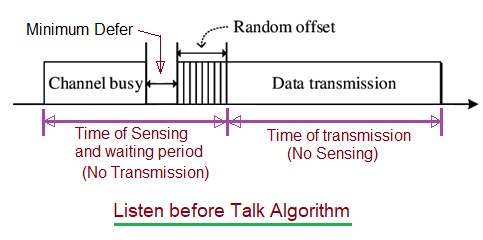Listen Before Talk (LBT) in Wireless Communication
Advertisement
This page delves into the Listen Before Talk (LBT) algorithm, a crucial component in modern wireless communication systems. We’ll explore the benefits and drawbacks of LBT.
What is Listen Before Talk (LBT)?
LBT emerged as a solution to overcome the limitations of the ALOHA technique. ALOHA, an early packet-based network, allowed transmitters to send data immediately without checking the channel’s availability. This led to collisions, and ALOHA only worked efficiently up to about 10% channel utilization.
With LBT, devices first “listen” to the radio channel. If the channel is idle (no ongoing transmission), the device transmits its data. If the channel is busy, the device waits for a random period and then retries transmission.

WiFi uses LBT in conjunction with sophisticated signal processing to intelligently manage radio spectrum usage. It’s also employed in LTE-U (Long Term Evolution Unlicensed) and LTE LAA (Licensed Assisted Access) networks.
Two primary methods determine if a channel is occupied:
- Carrier sensing: Detecting the presence of a carrier signal.
- Energy detection: Measuring the energy level in the channel to identify potential transmissions.
Benefits or Advantages of Listen Before Talk (LBT)
Here are the key advantages of LBT:
- Mitigation of Hidden Node Problems: LBT helps reduce the negative impact of hidden nodes, which are devices that can’t directly “hear” each other but can interfere with transmissions to a common access point.
- Collision Avoidance: It reduces the probability of collisions when multiple devices attempt to transmit simultaneously.
- Efficient Channel Utilization: LBT allows for better use of the radio channel compared to the ALOHA protocol.
- Reduced Re-transmission Needs: Due to the decreased collision rate, devices don’t need to re-transmit data as often, improving efficiency.
Drawbacks or Disadvantages of Listen Before Talk (LBT)
Here are the main disadvantages associated with LBT:
- Power Requirements: Self-powered devices may struggle to implement LBT due to the energy needed for continuous channel sensing.
- Time Overhead: The channel sensing process consumes valuable airtime. The time spent listening could otherwise be used for data transmission. Devices must listen for a period and then potentially wait a random time before transmitting, adding delay.
- Implementation Complexity: LBT requires a relatively sophisticated computer processor and accurate time synchronization, making it more complex to implement.
Advertisement
 RF
RF



